|
St. Andrew's College, Aurora
St. Andrew's College (SAC) is an independent boarding and day school founded in 1899 and located in Aurora, Ontario, Canada. It is a university-preparatory school for boys in grades 5 to 12, with a focus on academic achievement, athletics, and leadership development. It is accredited by the Canadian Educational Standards Institute and is affiliated with other associations, including CAIS, CASE, NAIS and the International Boys' Schools Coalition (IBSC). The school's coat of arms was registered with the Canadian Heraldic Authority on August 15, 2006.[3] HistorySt. Andrew's College was first situated at the northeast corner of Yonge Street and Roxborough Avenue, in the Toronto neighbourhood of Rosedale, in a house named Chestnut Park previously owned by Sir David Macpherson. The college opened on September 10, 1899 under the direction of Headmaster Rev. George Bruce. The first student to enroll was Douglas W. Fraser ('06). By the end of the first school year there were 56 students, including 13 boarders.[4]  Rev. Bruce was succeeded by D. Bruce Macdonald as Headmaster in 1900, and in 1901 the school published its first yearbook: The Review. The Old Boys Association, still active presently, was founded in 1903. In 1905, due to the increasing size of the student body, the school moved to a new campus within Rosedale, west of MacLennan Avenue, from Summerhill Avenue to Douglas Drive just north of Rosedale Field, in a large Collegiate Gothic structure. The Rosedale Campus was designed to serve 150 boarders, 300 day boys, and 9 masters. By 1909, the college had students from Canada, Jamaica, the United States, Mexico, Costa Rica, Panama, China, and Bermuda. In 1911, the college became a corporation under the control of a Board of Governors. Over 600 Old Boys fought in the First World War, and 104 lost their lives along with 2 masters. From 1918 to 1920, the college temporarily moved to Knox College, as the Rosedale Campus served as a military hospital for wounded soldiers from the First World War.[5] The school made its final move in 1926 to Aurora, where the current campus occupies a 126-acre (0.51 km2) site in a suburban environment. Its Georgian Revival architecture is built around the traditional quadrangle form. The Memorial Gateway entrance was completed in 1928. Over 600 Old Boys served during the Second World War, and 45 lost their lives. Plaques listing the names of those who lost their lives are displayed in the Memorial Chapel. 1956, the school magazine The Andrean was created and has been published since. There are four boarding houses on campus, which is home to approximately half of the 651 boys. Many members of the faculty also live on-campus. The Aurora campus was featured in the filming of Cadet Kelly and the 5th episode of the Netflix mini-series The Queen's Gambit.[6] Cadet CorpsSt. Andrew's is also home to Canada's second largest Royal Canadian Army Cadets Corps. Established in 1905, the #142 St. Andrew's College Highland Cadet Corps is now a multi-year leadership program, but still culminates in an annual inspection and parade in April. 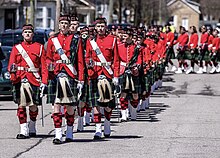 The cadet corps was raised in the fall of 1905 following the model of military training offered at Upper Canada College and Trinity College School. The Corps was under the direction of schoolteacher and militiaman Capt. Grant Cooper and Drill Instructor Sgt. Alfred R. Hatt, who had fought with the Gordon Highlanders at Chitral and in South Africa. The first Cadet Inspection was held at the Rosedale Campus on May 14, 1906, under the Command of Captain Cooper, and the first student cadet commander was First Lieutenant Vincent Massey. On April 24, 1906, the corps made its first public appearance at Queen's Park where it was reviewed by the Duke of Connaught, and on May 18 it participated in training drills with the 48th Highlanders. The cadet corps provided a guard of honour during the Royal Tour of 1939. 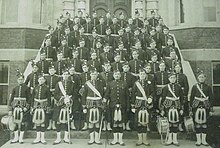 The School's cadet corps is affiliated with the 48th Highlanders of Canada and retains the same motto ("Dileas Gu Brath" – "Faithful Forever") as well as uniform (scarlet tunic and Modern Gordon tartan). In 2005, the centennial year, the Corps was granted the Freedom of the City of Aurora.[4] Pipes and DrumsThe Pipes and Drums is an integral part of the Cadet Corps and one of its best-known elements. The Pipes and Drums were established in 1915 under the tutelage of Pipe Major James Fraser of the 48th Highlanders, formerly of the Gordon Highlanders who had fought at Dargai and in South Africa. In 1941, a jaguar skin that had been shot by Theodore Roosevelt was donated to the college to be worn by the bass drummer.[7][8] The primary responsibility of the Pipes and Drums Band is to provide music for the Battalion when it is on the march. In this role, the Band is front and centre during the Annual Church Parade, Head of School's Parade, and the Annual Cadet Inspection in April. Internationally renowned as "North America's piping heartland" for its Piping and Drumming program, St. Andrew's College attracts hundreds of potential pipers each year to its summer "Ontario School of Piping and Drumming at St. Andrew's College" camp.[9] In June 2019, the decision was made to field a competitive band in grade 2 alongside the existing band, which competed in grade 5.[10] Headmasters
Academics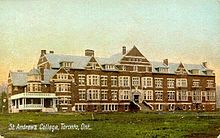 The school's mission statement is Dedicating ourselves to the development of the complete man, the well-rounded citizen. Every classroom and common area at St. Andrew's College is covered by a wireless network.[11] The faculty is divided into 12 departments, those being Business, Computer Science and Engineering, Drama, English, Guidance and Career Education, Health and Physical Education, Mathematics, Modern Languages, Music, Science, Visual Arts, and World Studies.[12] The students have a broad selection of courses to available to them from the fine arts, to the humanities, social sciences, science, and engineering. Many AP courses are also offered, for example AP Chemistry, AP Capstone, AP Calculus, AP Statistics, AP Economics, AP Biology, and AP Computer science, among others. SAC has a 100% university acceptance rate and graduates move on to post-secondary education around the world, including Canadian, American and British universities.[13] AthleticsSports are considered an essential part of school life and culture; 72 teams across 22 sports are offered by the School. St. Andrew's College is one of the original members of Ontario's "Little Big Four" (the others being Ridley College, Trinity College School, and Upper Canada College). The photographs of each year's representative teams line the walls along the first and second floors of the Bedard Athletic Centre. Sports are mandatory — all Upper School boys must participate in two out of three sports terms during the year, while Middle School students must participate in all three terms.[14] St. Andrew's has a tradition of sporting, as shown by its participation in both private and public school leagues and associations:[15] Private schools competition
Public schools competition
St. Andrew's College has representative teams for the following sports, in addition to the Craze Sports intramural program: WinterSchool eventsEach year, St. Andrew's hosts events that are unique the School. Some of these activities and events involve the entire student body, while others are directed towards alumni and their friends and families. These events serve different purposes, some of which are integral to the School's identity while others are used for fundraising causes. 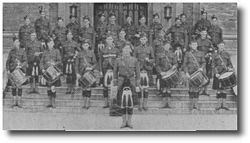
StudentsSt. Andrew's College is divided into the Middle School (grades 5–8), and the Upper School (grades 9–12). More than half the of the student population live in boarding. Upper School day boys from York Region are a part of the four day houses: Ramsey, Laidlaw, Smith or Perrier. Macdonald House is the home to all grade 5–9 boarders, and some select grade 11's who are designated house captains and act as 'big brothers'. Macdonald House is named after the MacDonald family (J. K. MacDonald and J. K. MacDonald II both served as Board Chair and Bruce MacDonald was Headmaster). The remaining Upper School boarders live in the remaining 3 boarding houses:
Upper School Clans:
The programs for Middle School students are generally independent of those for Upper School. Each Middle School student is also part of a clan, where they participate in various activities to earn Clan Points. The clans are Douglas, Montrose, Wallace, and Bruce. In addition, St. Andrew's students hail from an array of different backgrounds. Nearly 50% of the boarding community is international, coming from such countries and regions as Bermuda, Korea, Bahamas, Mexico, Hong Kong, Japan, Taiwan, the Philippines, Germany, Indonesia, Spain, Bermuda, China, Nepal and the United States to name a few. The remaining half are from various provinces across Canada. FacilitiesEarly 2000's expansionIn 1999 the architectural firm KPMB headed a project which consisted of planning for a new middle school and parking lot on the established campus.[23] From 2000 to 2003, the same architectural firm had an additional project which included the addition of a middle school wing onto an existing building, a parking lot and outdoor spaces and alterations to the existing college, originally constructed in 1926.[24] McLaughlin Hall renovationIn late 2019, The Dalton Company executed a project which saw the complete internal-reconstruction of all 3 floors within the McLaughlin Hall science building. Covering a total area around 26,000 sq ft of space. The original facility was constructed in 1970, also by The Dalton Company and they were invited back 50 years later to renovate the building. In the CAD $10 million project, the entire interior of the building was reduced back to the core structure, and reconstructed with state of the art facilities for science and technology. Included are university-level chemistry and biology labs, as well as a two-story maker-space and robotics/computer science classrooms.[25] The newly renovated McLaughlin Hall also houses a Foucault Pendulum on display which spans vertically through all 3 stories of the building. The pendulum was originally added in 1971 as it was donated following the death of a young student and was re-fitted to the new building.[26] La Brier Family ArenaThe La Brier Family Arena is a multi-purpose hockey arena which also houses fitness facilities located on the St. Andrews College campus. It began construction in 2013 after a CAD $5 million donation from the La Brier Family of which it is named after.[27] It was completed in 2014 and was officially opened on September 20, 2014,[28] and serves as the home base for the school's hockey team, the Saints.[29] [30] Academic facilitiesCoulter Hall – A three-floor classroom building opened in 1962[31]—the second and third floor is designated for use by the Math and English departments, respectively. The first floor (or basement) houses the office for the mathematics faculty, while also serving as a link between the north end of the Staunton Gallery, and the basements of Dunlap Hall and the CLIP building. McLaughlin Hall – A three-story wing connecting the Bedard Athletic Centre, Coulter Hall, and Rogers Hall, originally opened in 1971, it underwent a massive renovation between 2019 and 2021 and serves as the science building with facilities for chemistry, physics, biology, and is fitted with a 2 story maker space and computer science classrooms.[32] Rogers Hall – A classroom wing built in 2003, all Middle School classes take place here, save for music and art. It is named after lead donor Dem Rogers '59. The Center for Leadership, Innovation, and Performance (CLIP) – A fairly new 3-level addition to the campus (2015), which is home to the Business, Geography, Theatre, and Music departments. Music classes and rehearsals occur in CLIP, while the Wirth Theatre (modelled after Stratford's Festival Theatre) is home to the Theatre department. The Wirth Theatre is supported by the Reininger Rehearsal space under it and is also connected to the main auditorium which seats over 400 people for school assemblies and ceromonies. Towers Library – Named after Graham Towers, the first governor of the Bank of Canada, and an Old Boy. Student and school facilitiesCole Hall – The dining hall where breakfast, lunch, and dinner are served daily. It is also the site for formal meals and ceremonies. The Cadet offices are located in the basement of Cole Hall. Memorial Chapel – Built in 1931, it is the School's Chapel, and is dedicated to the Andreans who fought and died during World War I and World War II. The donation was made by Sir Joseph Flavelle, who also donated funds to establish Flavelle House. Morning services and special services such as the Remembrance Day Service are held in the Memorial Chapel. 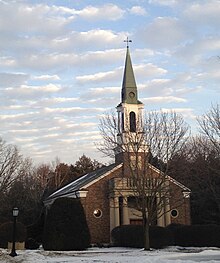 Dunlap Hall – This is one of the original four buildings on campus. Today it houses the School's administration. The first floor includes Head of School's office, admission office, administration office, and university counselling. It is also connects to the library. The second floor houses the alumni and advancement office and the business office. In the basement are the day boy lockers as well as the multi-faith prayer room. Staunton Gallery – A now-converted outdoor courtyard, it is a popular place for students to congregate, and was dedicated to departing Headmaster Ted Staunton. It connects to the Wirth Art Gallery, Dunlap Hall, Ketchum Auditorium, Coulter Hall, CLIP, McLaughlin Hall, and Rogers Hall.[33] Bedard Athletic Centre – This building, opened in 1979 (with an addition in 1990) and named after the School's sixth Headmaster, Robert Bedard, is home to many of SAC's athletic needs. It houses one of the two gymnasiums on campus, as well as 6 international squash courts, a 25-metre six lane indoor swimming pool, a fitness and weight training facility, 10 locker rooms, and a fully staffed sports injury/athletic therapist clinic. The Modern Languages Department teaches French and Spanish in the second-floor classrooms of the building, with Health and Physical Education classes taking place in the gymnasium. Since September 2022, it also houses a donated golf simulator.[34] Yuill Family Gymnasium – The main athletic facility, attached to Roger Hall, for the Middle School and after-school Upper School sports practices. It is also home to a rock wall. Upper School June exams are held here. It was named after Old Boy Bill Yuill '57. Yuill Family Athletic Complex – A collection of sports fields for the school, the highlight being the synthetic football and soccer turf field, complete with seating for 800, press box, and scoreboard. Surrounding the field is a 6-lane regulation track. The complex also includes a regulation-size baseball diamond, batting cages, warm-up mounds, and multipurpose athletic courts (including tennis and basketball). The complex was completed in Spring of 2012 and is named for its lead donor, Old Boy Bill Yuill '57. Notable faculty
Notable alumni
St. Andrew's notable alumni, known colloquially at the school as 'Old Boys', include: Arts
Business
Media
Military
Politics
Science
Sports
Notes
References
External linksWikimedia Commons has media related to St. Andrew's College. |
||||||||||||||||||||||||||||||||||||||||||||||||||||||

